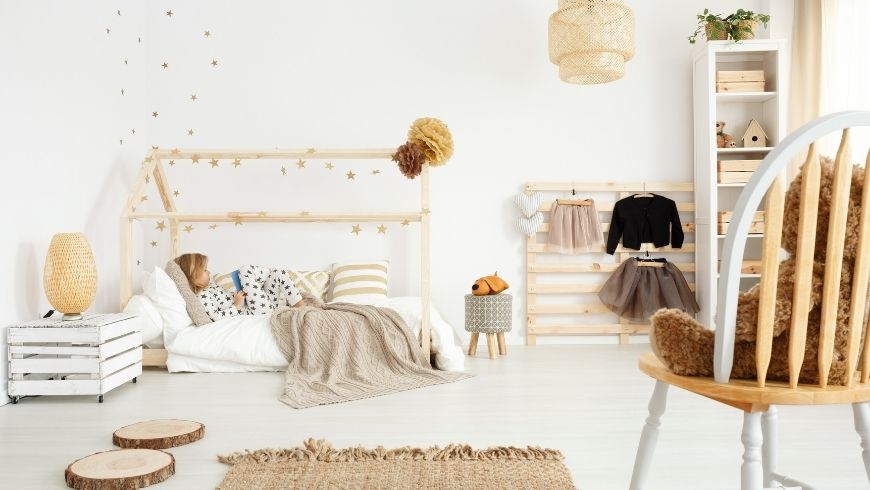When you think of an ideal bedroom you are thinking about a space that inspires comfort and good sleep. With the rising trend of increased workload and interference of technology in our everyday life, more and more people around the globe are reporting trouble sleeping. With the ever-growing threat of global warming and heightened carbon emission, what we as responsible human beings should strive to achieve is a sustainable way of living with the broader aim of conserving the natural resources of our precious home planet. It is therefore an amazing endeavor to move towards a bedroom that comprises more eco-friendly products rather than synthetic and toxic ones. Let us without further ado look at some of the ways in which we can achieve eco-friendly sleeping and how it can impact our lives for the better.
1. Opt for non-toxic paints
Most synthetic paints are comprised of volatile organic compounds (VOCs), prolonged exposure to which can lead to a number of health problems such as liver damage, kidney failure, cancer, etc. To avoid exposure to these harmful fumes, and minimize contamination of the environment, you should pick paints that are environmentally friendly and non-toxic in nature. Such paints are mostly made up of materials such as plant-based pigments, milk protein, natural minerals, essential oils, etc. For an improved sleeping experience, consider picking lighter shades of green and blue rather than stimulating bright shades of red and yellow or dull hues like gray and black.

2. An organic mattress
One of the biggest favors that you can do to the health of your sleep and that of your planet is opting for mattresses made of organic materials. When you look closely into the composition of your synthetic mattresses, you realize that most of them contain materials that can prove harmful in multiple ways and are mostly non-biodegradable. Foam mattresses, for example, contain toxic components like isocyanates, naphthalene, benzene, etc. Similarly, latex mattresses made using chemicals can contain VOCs and other allergens. On the other hand, using organic mattresses made from natural materials such as coconut husk, organic wool, cotton, bamboo, hemp, etc., ensures better breathability, prevention against skin allergies, recyclability, and prevention against harmful pesticides, dyes, adhesives, etc.

3. The bedding material
Just as organic mattresses, you should be looking to choose more naturally available materials over synthetic ones. Sheets, pillow covers, quilts, etc., made with a polyester blend or foam pillows that contain polyurethane can cause a number of ailments to your body such as troubled breathing, skin rashes, allergy, etc. The polyurethane manufacture process is involved in heavy carbon dioxide emission whereas the production of polyester can lead to widespread water and air contamination. Go for natural materials such as silk, cotton, linen, wool, bamboo, lyocell, etc. Not only do these materials prevent heat-trapping and skin irritations but are also comfortable enough to ensure that you complete your required 7 to 9 hours of sleep on a consistent basis.

4. Home décor that is greener
By a greener home décor, we mean decorative items that are environment-friendly such as energy-efficient lighting, wooden candle holders, placing indoor plants, using curtains made of linen or hemp, etc. Replacing your regular old synthetic decorative items with more sustainable materials like clay, wood, natural fibers, etc., can have a drastic impact on the room’s appearance and your health. Get rid of traditional high voltage lights and invest in CFLs or LED bulbs that can cut your energy expenditure drastically and help improve sleep quality due to their softer light. Cut back your power usage further in the daytime by opening your windows wide in the morning to increase your sunlight exposure and facilitate the flow of fresh air in the room. Fill your bedroom, window sills, and balcony area with plants such as the snake plant, aloe vera, the peace lily, etc., that boost air circulation and combat toxic gases. Recycle old wooden blocks and bamboo pieces into decorative items such as photo frames, flower vases, pen holders, etc.

5. Choosing your furniture
Researchers in the past have found that the average sofas, beds, and carpets that come with a lining of flame retardants meant to suppress fire incidents can prove hazardous when such events occur. The chemicals used in inlining can react with the fire to release harmful gases like carbon monoxide and hydrogen cyanide. Similarly, furniture made from engineered wood while being comparatively cheaper is laced with toxic components like formaldehyde. Such wood is manufactured in factories under extreme pressure and fail to last long when put in use. It is therefore wise to invest in solid wood furniture, even if it is a used one. Using products made from recycled wood, therefore, reduces the strain on the environment by preventing factory waste and cutting of trees. Apart from wood, you can also go for furniture made from reclaimed glass and metal.

Bottom line
Eco-friendly sleeping is a fragment of an overall eco-friendly living where you try to replace lifestyle habits with those that help reduce the carbon footprints such as carpooling, using bicycles, eating seasonal foods, and switching to cleaner forms of energy. If you haven’t yet tried out these habits, following the above-mentioned tips to achieve an eco-friendly sleeping environment can prove as just the start you need.
Cover image: photo via Canva Pro




